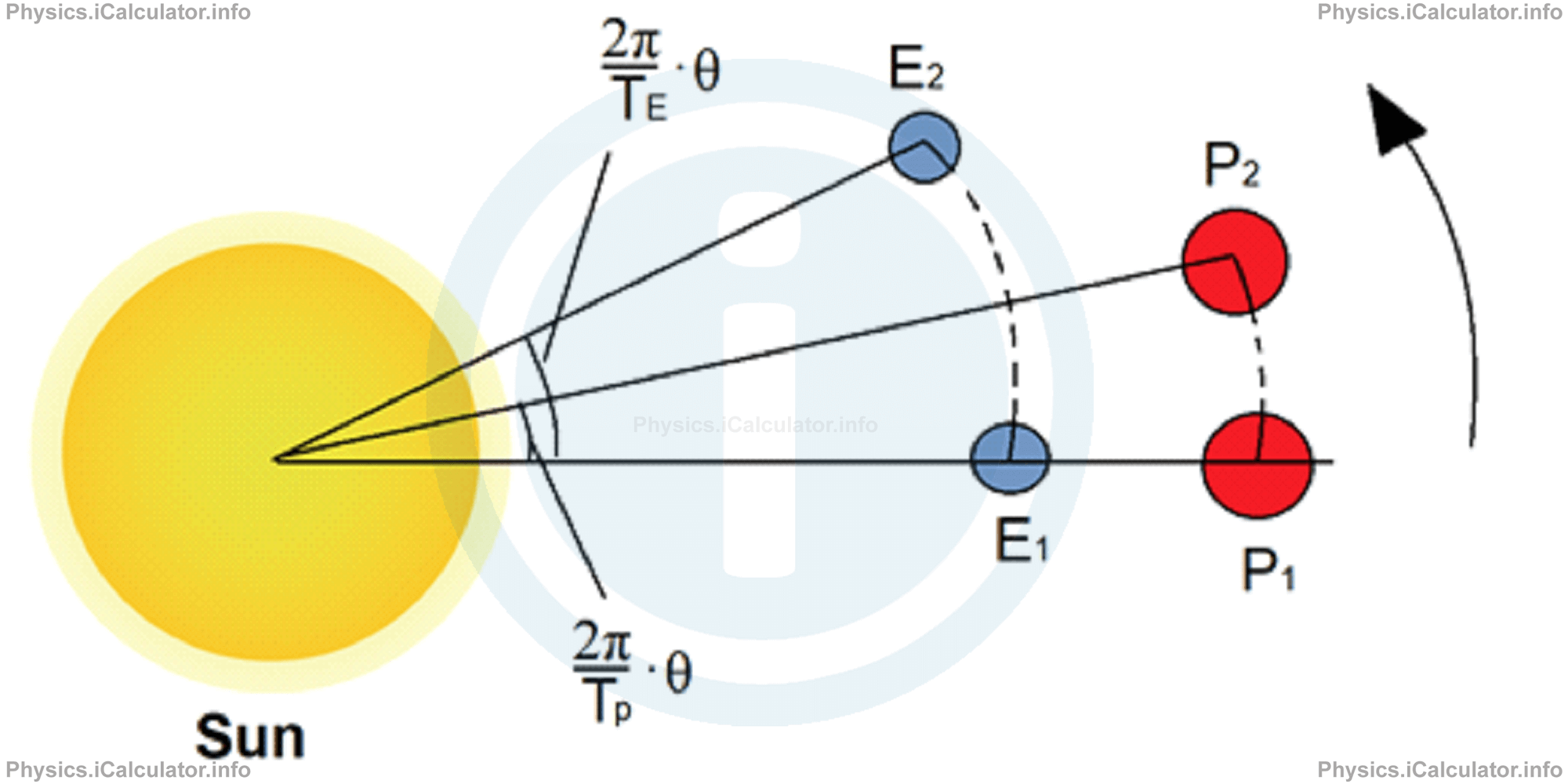Menu
Physics Lesson 22.3.5 - Calculating the Time Needed for the Earth and Another Planet to Realign Again
Please provide a rating, it takes seconds and helps us to keep this resource free for all to use
Welcome to our Physics lesson on Calculating the Time Needed for the Earth and Another Planet to Realign Again, this is the fifth lesson of our suite of physics lessons covering the topic of The Moon's Movement. Eclipses. Calendars, you can find links to the other lessons within this tutorial and access additional physics learning resources below this lesson.
Calculating the Time Needed for the Earth and Another Planet to Realign Again
Let's select an outer planet for this task (one from Mars to Neptune). We take as initial value of time the instant when the Sun, Earth and the planet are collinear. The Earth revolves around the Sun at angular velocity
where TE is the stellar (sidereal) period of Earth revolution.
On the other hand, the other planet revolves around the Sun at angular velocity
where Tp is the stellar (sidereal) period of planet's revolution.

Given that, in this instance, we are considering an outer planet (its distance from the Sun is longer than that of the Earth), the stellar period of planet is larger than stellar period of the Earth because the angular velocity of planet is smaller than that of the Earth (the planet rotates slower than the Earth around the Sun). This means the Earth has made more revolutions around the Sun than the given planet when they align again in the same direction. Obviously, during this time the Earth has made more than one revolution around the Sun (assuming that the planet has made at exactly one revolution around the Sun).
We denote by θ the time required for this process (i.e. the synodic period of the planet). We have
where 2π is the complete angle in radians.
Simplifying both sides by 2π, we obtain
1 = θ/TE -θ/Tp
Dividing both sides by θ, we obtain
This approach can be used to calculate the realignment time of the two inner planets (Mercury and Venus) as well. The only difference is that the Earth rotates slower this time. Hence, the above formula becomes
Example 3
Assuming that today the Sun, Earth and Mars are perfectly aligned, calculate the next time when this phenomenon will occur. Take the following values for periods of revolution around the Sun: TE = 365.24 days and TM = 686.97 days.
Solution 3
Mars is an outer planet, so we must use the first formula. We have
= 1/365.24 + 1/686.97
= 0.0027379 + 0.0014557
= 0.0041936
Thus, the new alignment of planets will occur in
= 238.46 days
You have reached the end of Physics lesson 22.3.5 Calculating the Time Needed for the Earth and Another Planet to Realign Again. There are 5 lessons in this physics tutorial covering The Moon's Movement. Eclipses. Calendars, you can access all the lessons from this tutorial below.
More The Moon's Movement. Eclipses. Calendars Lessons and Learning Resources
Whats next?
Enjoy the "Calculating the Time Needed for the Earth and Another Planet to Realign Again" physics lesson? People who liked the "The Moon's Movement. Eclipses. Calendars lesson found the following resources useful:
- Calculation Feedback. Helps other - Leave a rating for this calculation (see below)
- Cosmology Physics tutorial: The Moon's Movement. Eclipses. Calendars. Read the The Moon's Movement. Eclipses. Calendars physics tutorial and build your physics knowledge of Cosmology
- Cosmology Revision Notes: The Moon's Movement. Eclipses. Calendars. Print the notes so you can revise the key points covered in the physics tutorial for The Moon's Movement. Eclipses. Calendars
- Cosmology Practice Questions: The Moon's Movement. Eclipses. Calendars. Test and improve your knowledge of The Moon's Movement. Eclipses. Calendars with example questins and answers
- Check your calculations for Cosmology questions with our excellent Cosmology calculators which contain full equations and calculations clearly displayed line by line. See the Cosmology Calculators by iCalculator™ below.
- Continuing learning cosmology - read our next physics tutorial: Stars
Help others Learning Physics just like you
Please provide a rating, it takes seconds and helps us to keep this resource free for all to use
We hope you found this Physics lesson "The Moon's Movement. Eclipses. Calendars" useful. If you did it would be great if you could spare the time to rate this physics lesson (simply click on the number of stars that match your assessment of this physics learning aide) and/or share on social media, this helps us identify popular tutorials and calculators and expand our free learning resources to support our users around the world have free access to expand their knowledge of physics and other disciplines.